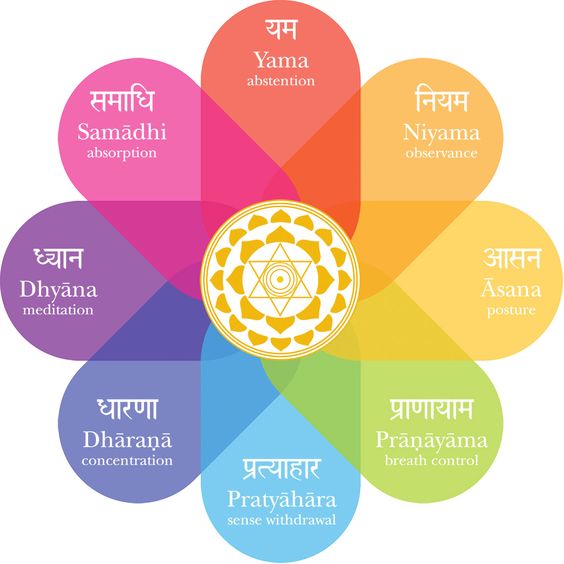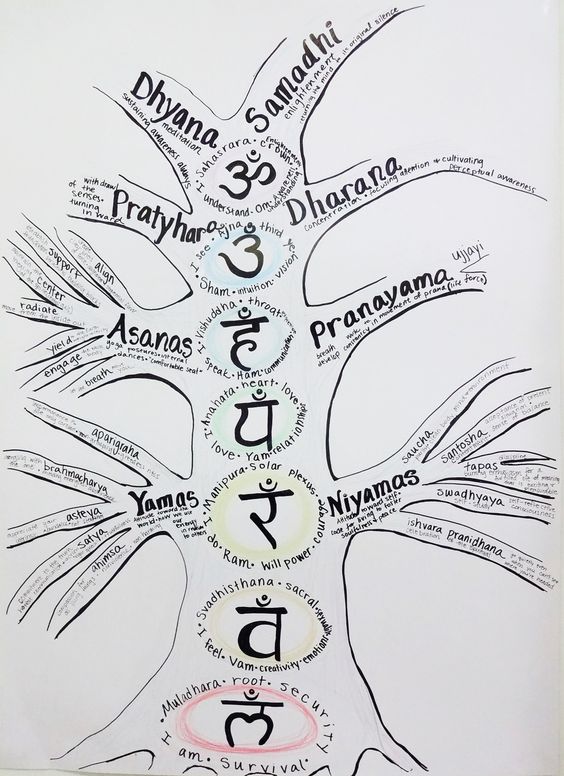The 8 limbs of Yoga
Fundamental bases of practice
The 8 limbs of Yoga, also known as Ashtanga Yoga, are the fundamental foundations of Yoga practice. They were developed by a sage named Patanjali, about more than 2,500 years ago in ancient India.
Patanjali wrote the Yoga Sutras, a book that contains 196 aphorisms about the philosophy and practice of Yoga. It is there that we find the first references to the 8 limbs of Yoga, which Patanjali describes as the steps to achieving spiritual enlightenment.
Each of these members are fundamental aspects in the practice of Yoga and work together in personal development. By practicing them, we can achieve harmony in our lives, promoting health, emotional balance, mental clarity and a deep sense of spiritual connection.
No matter where you are on your journey, the eight limbs of yoga stand like a faithful compass, pointing toward the truth of self and the unexplored horizons of spiritual evolution.

Learn more about each limb:
1 Yamas - These are ethical principles that govern human behavior and relationships with others. They include non-violence (Ahimsa), truth (Satya), non-stealing (Asteya), moderation (Brahmacharya) and non-attachment (Aparigraha).
2 Niyamas - Niyamas are personal principles that help to develop inner discipline. They include purification (Saucha), satisfaction (Santosha), discipline (Tapas), self-study (Svadhyaya) and devotion (Ishvara pranidhana).
3 Asanas - They help to strengthen and make the body more flexible, as well as improving posture and balance and calming the mind by preparing the body for meditation.
4 Pranayama - They are the breathing exercises of yoga, known as Pranayama, used to control breathing and increase vitality. They can help calm the mind, detoxify the body and reduce stress.
5 Pratyahara - Pratyahara is the practice of withdrawing attention from external stimuli and directing it towards the internal world. This helps to develop concentration and introspection.
6 Dharana - Dharana is the practice of developing concentration and mental stability by fixing the mind on an object, sound, thought or point of reference.
7 Dhyana - Dhyana is the practice of meditation, where the mind is calm and alert. This helps to develop mental clarity, discernment and insight.
8 Samadhi - Samadhi is the great objective, the state of plenitude and spiritual enlightenment, in which the mind is at peace and in union with the universe.

The Yamas and Niyamas are based on ethical and personal principles that Patanjali believed were fundamental to a happy and fulfilling life. They were inspired by the teachings of the Vedas, ancient Hindu sacred texts.
Asanas, the third limb of Yoga, was later developed by practitioners of Hatha Yoga, a style of Yoga that focuses on physical positions and breathing techniques. Asanas have become an important part of Yoga practice, helping to strengthen and relax the body in preparation for meditation.
Pranayama, Pratyahara and Dharana are described in the Yoga Sutras as techniques of concentration and mind control, which are essential for achieving union with the divine.
Dhyana, the penultimate limb of Yoga, is the practice of meditation, in which the mind is calm and focused. It leads to clear perception and the development of spiritual awareness.
The last limb of Yoga is Samadhi, a state of spiritual realization and enlightenment, superconscious perception, and the highest purpose of human life.
Today, the 8 limbs of Yoga continue to be an essential part of the practice of every type of Yoga throughout the world. They represent a path of self-discovery, personal growth and spiritual development that can help people find peace, happiness and well-being in their lives. Although each of these limbs can be practiced independently, they work together to achieve integration between body, mind, and spirit. Therefore, it is important to explore each of them in your practice to feel the individual benefits and discover how they can help you achieve a state of peace, balance and well-being.

 Chinese (Traditional)
Chinese (Traditional) English
English French
French Hindi
Hindi Portuguese
Portuguese Russian
Russian Spanish
Spanish